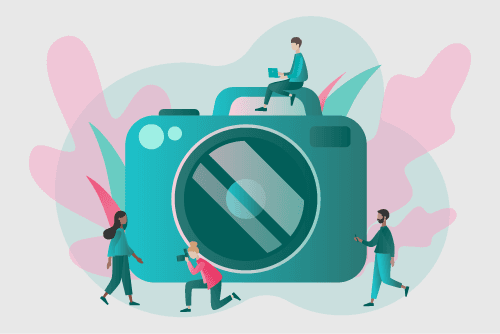5 Steps to Becoming a Professional Photographer

Photography is a bold career choice that suits people with a blend of artistic flair, technical skills, and entrepreneurial thinking.
If you’ve always been fascinated by the photographic arts, and you dream of a creative career that pays the bills, photography can be a practical way to make a living while expressing yourself creatively. Over your lifetime, you can build a body of work that you’re proud of and spend your working days doing something you love. In this career toolkit, we’ll guide you through each stage of becoming a professional photographer.
I worked photography for 4 years as a freelance photographer after completing a Diploma at TAFE. During that time, I was photographing and videoing work for my own portfolio and clients. I was also assisting experienced photographers on shoots, freelance editing and retouching, and shooting jobs for other photographers.
While I changed careers after realising that this occupation wasn’t a fit for me, some of my friends continue to work and thrive in the industry. We all made slightly different choices after studying, which led us in different directions. That’s the wonderful variety of the photography trade for you – it’s very much a ‘choose-your-own-adventure’ experience, and indeed nothing if not self-directed.
This career kit will brief you on answers to these questions and more in five chapters.
Ready to get started?
Lens Caps Off.
1.
What Photography Involves
Photography is a distinctive career choice with its own set of rewards and challenges. Find out whether the industry will suit you.
2.
Learning Photography
There is no ‘right’ way to learn photography skills, but you will need some form of training and essential equipment.
3.
Choosing a Niche
Some photographers are generalists, but it’s more common to focus on one particular niche.
4.
Starting Your Photography Career
Whether you choose to go solo as a freelancer or start a business will determine your path in the industry.
5.
Resources
Want more information or inspiration? Want to deep-dive into a particular topic? We’ve got you covered.
Photography Job Description
What do photographers do on a daily basis? They take photos, of course, but there’s much more going on behind the studio doors. This is what you’ll find photographers doing on any given day:
CHAPTER 1
Decide if Photography is for You
Not Sure What Direction to Take?
You don’t need to know what exactly you want to do before you start. Photography is especially suited to – and demands – the lifelong learning approach. Once you’ve done your basic training, start working and then take on more training and upskilling as you go with short courses and workshops for particular skills.
Formal Qualifications are Less Important
Career progression is determined by photographic and business skills, the right equipment, and being fantastic with people. Taking great photographs is a minimum requirement; to be a successful photographer requires providing your clients with impeccable service. Since you need no formal qualifications or certifications to take photos, it’s open to anyone, in theory. But in practice it’s often fiercely competitive and demands a high level of commitment. This is a job that requires you to continually hone your craft and upskill, invest serious money in equipment, and build a photography portfolio over time.
Photography is Equal Parts Creative, Technical, and Business
It’s an adventurous career path involving considerable risk, but also significant rewards to those who prefer to chart their own course. As a professional photographer, be clear that you are a tradesperson, not an artist. You give your clients both a service and a tangible good that helps them fulfil a need. If you want to pursue art, you can always execute personal projects in your spare time.
Does Photography Have a Future? The State of the Industry
Professional photography is growing fast. The Australian government makes Strong Growth Projections for the next 5 years (source). Unfortunately, this data does not factor the impacts of COVID-19, but it’s feasible to guess that, as businesses increasingly move online, the demand for product and commercial photography will rise. Some niches may decline, but at this point it’s hard to say exactly which ones and how much.
Predicted Employment Growth
Can You Make a Living Doing Photography?
17,900 Australians make their living doing photography. If they can do it, then with the right skill sets, practice, and experience, then why not you?
Do Photographer Make Good Money?
Photography jobs are usually priced by the hour or the day. Photographers charge anywhere from $500 (for beginners) to upwards of $5000 a day. That may seem high, but you’ll need to subtract running costs from your photographer’s fee to find your real hourly rate.
Some examples of standard costs include equipment, marketing, and account for the hours you will spend in pre- and post-production (which often vastly outnumber the hours you devote to shooting) .
Photographer ‘Salaries’
Yearly income varies widely across industries, but these are some typical ‘salaries’ for different kinds of photographers.
For ease of understanding, hourly rates have been translated into yearly salaries, though most photographers work variable hours.
How Much Do Entry-level Photographers Make?
Assisting
Photography assistants are usually paid by the day. Standard rate is $250/day in Melbourne, but it varies between photographers and companies.
Editing
Editing rates start at around $20-25/hr and increase with experience. This can be an excellent way to get experience with post-production, which can make or break your photography. It can also teach you to understand the importance of useful digital workflows and reliable file management systems.
Get a Security Gig
It can be very up and down, to begin with, so it’s a good idea to work a part-time job a few days a week for a stable income – so you don’t starve while waiting for companies to pay your invoices.
Is It Too Late to Become a Photographer?
Starting photography later in life gives you some key advantages.
Having been a young photographer, I observed that older photographers can have an easier time establishing trust with the client. Even if you’re less experienced or trained, they tend to assume you know what you’re doing – it may not always be a fair assumption, but first impressions count. If you’re in your early twenties and your clients are a decade or more older than you, they will find it hard to trust in your abilities until you go above and beyond to prove yourself.
As an older person, you have the benefits of life experience, which can include communication skills, a professional demeanour, and assertiveness, which often take time to build. It’s also likely that you are better equipped to handle the complex, challenging situations that will inevitably come up.
As you get older, you often have more spare time, which means more time to hone your craft. Also, you may have more money available. The benefits of this are twofold: It means more freedom to choose the types of work you want to do, and more money to spend on equipment.
Case in point: Melbourne portrait photographer Nancy Flammea didn’t start photography until she turned 50.
Who is Photography Best Suited to?
Photography is perfect for you if:
Pros and Cons of Being a Photographer
| Pros | Cons |
|---|---|
| Start your own business | Seasonal income: Photography has busy seasons and low seasons. You may start busy, earning good money, but then hit a dry patch. |
| Be creative every day | Lots of business and adminstration work to do, too. |
| Work with the latest and best equipment | Equipment is expensive and needs to be insured and upgraded frequently |
| Be your own boss | Sometimes you get thrown into crazy situations and working conditions |
| Meet lots of people and have an extensive network of contacts | Sometimes work outside in unpleasant weather |
| Take holidays whenever you want | Work on weekends and evenings |
| Be proud of your work | Your ability to create good work is somewhat dependent on what equipment you can afford and access to talent |
| Keeps you fit | Lots of heavy lifting |
| Lots of variety | You can’t get too comfortable in your methods |
| Opportunities for travel | Lots of driving to different areas |
CHAPTER 2
Learning Photography
Is it Worth Getting a Degree in Photography?
What’s the best way to learn photography? Three photographers share their perspectives: one self-taught, one TAFE-taught, and one studying at university.
Find Out
How Do I Build Up an Equipment Kit?
Here is some general advice for beginners. While fine art photographers often shoot with film, digital is the industry standard. Clients will expect you to be able to shoot and deliver digital images.
Choose a Brand
Start with equipment from a reputable brand. It’s a good idea to choose a brand straight away. Inter-brand compatibility is not great, and once you invest in one system, you’re locked into the ecosystem. Most working photographers use a DSLR from either Canon or Nikon. If you’re interested in the technical side of things (and not all photographers are, past what they need to know), you may want to go deeper with your research. Recently, Panasonic and Fuji have also been creating some competitive camera systems that you may want to check out.
Be Frugal
Buy second-hand, especially when it comes to lenses. You can often re-sell lenses for a similar price to what you bought them for, provided they’re in good shape. Camera bodies with a higher shutter count can require expensive repairs soon after purchase, so try and shoot for something with under 100,000 shutter count.
Be a Kit Stalker
Read about different photographers and what’s in their equipment kits. Find out why they chose what they did. Shotkit is good for this.
Think About Results
Learn more about what kind of equipment suits your needs as you go. Different photography style requires a different kit. Think about what you want to achieve, and work backwards from that. Pixel Peeper lets you see images produced by specific pieces of equipment.
Don't Hoard
There’s not much point accumulating gear for the sake of it. Though the right equipment is often a precursor to taking a particular kind of photo, it certainly doesn’t guarantee it.
What Lenses Should You Start With?
Once you’ve passed the absolute beginner stage, it’s time to upgrade your lenses to professional quality. Professional photographers aren’t caught dead with the ‘kit’ lens that comes with the camera body, because the lens you use is perhaps the most important factor in how your images look and feel.
Apologies to my Nikon friends; I used Canon exclusively while shooting and at TAFE, so I only speak Canon. Most brands will have an equivalent lens for each category. Here’s what you might consider for a starting lens kit, depending on what kind of photography you enjoy.
Portrait Photography
Love shooting people, pets, and some still life? Get a mid-range zoom with a longer focal length (24-105mm f/4). A 50mm prime will also do you well. The ‘nifty fifty’, aka 50mm f/1.8, has fantastic quality for the price, and produces almost indistinguishable images from the more expensive versions – but it does sometimes struggle with autofocus for moving subjects and in low light.
Documentary & Event Photography
Get a mid-range zoom with a lower f stop (24-70mm, f/2.8) and a Speedlite that will help with low-light situations and creative lighting effects.
Landscape & Architecture
Get a wide-angle zoom (16-35mm f4). F-stop matters much less since you’ll be on a tripod, but the better lenses will give you sharper images and less distortion. Also get a medium zoom (24-70mm f2.8) so you’ve covered most focal lengths. That is, until you add a telephoto.
Studio & Product
Studio lights mean you have plenty of light to play with, so lower f-stops are not a significant concern. You’ll want a workhorse mid-range zoom with excellent sharpness, and macro functionality for details. 24-70mm f/4 will serve you well, or 24-70mm f/2.8 if you have more cash. You may also want to consider a 100mm prime with macro.
Equipment research is a deep rabbit hole. May I suggest reading up on The Wirecutter before you start Googling away and end up frazzled?
CHAPTER 3
What Kind of Photographer Do You Want to Be?
Not all photographers work for the same kinds of clients. The genre and industry you work in will dictate whether your photography falls into the B2B (business to business) or B2C (business to customer) categories.
B2C vs B2B Photographers
What’s Trending in Photography?
Personal branding photography is a new, trending niche. Personal branding photographers produce photography to be consistent with a business’s branding. They usually work with small businesses, often producing portraits – but also covering still life and lifestyle styles.
Types of Photography
12 Types of Photography Careers to Make Your Passion a Reality
There is a multitude of photography types. We break down some of the most practical, lucrative, and trending styles and genres.
Read More
CHAPTER 4
Start Your Photography Career
How to Become a Freelance Photographer: What You Need to Know
Two freelance photographers share their best tips for breaking into the industry.
Read More
How to Start Your Own Photography Business
A portrait and personal branding photographer shares her tips for starting a small photography business from scratch, and scaling up.
Read More
How Do Beginner Photographers Make Money?
Common ways to get your first jobs in photography include:
Some less common ways to get jobs:
Should You Go Full-time Straight Away?
Full-time isn’t necessarily for everyone. Photography can be a great side job, and more often than not, it’s a better strategy to transition from a side hustle, then part-time, then to full time. A part-time job gives you a stable income while you’re building up a base of clients, as income can be unpredictable in the beginning.
Gradual, measured entry into the industry helps you to learn the ropes without making serious mistakes or getting in over your head. After all, your reputation is your most precious asset in the photography business: yes, more precious than that costly telephoto zoom lens you don’t let anyone else touch.
Here’s a step by step plan for getting started:
- Start with assisting experienced photographers, especially if you admire their work.
- Save some money for investing in gear and paying tax.
- Do collaborations with other creatives to build a portfolio. An online portfolio is a must – consider Instagram to start with, and later add a website.
- Take on small jobs through your extended network.
- Do your best work, all the time. Always over-prepare and only hand over your best shots to the client. Blow clients away with your personal service and attention to detail.
- As you do more jobs, purchase better equipment: a second camera body, a prime lens, a telephoto, better Speedlites, and a basic two-flash lighting kit.
- Build up a base of repeat clients through word of mouth: your ultimate marketing tool.
- As you get more and more jobs booked, reduce the hours you work at your other job.
- Get even better equipment. Think about setting up a small studio if you have a spare room.
- Quit your security job. You’re a full-time photographer now! Congratulations.
- Keep pushing to become better technically and artistically. Always read and take in new work. Read photography books and blogs. Watch documentaries about great photographers. Experiment with new techniques and concepts. Take short courses and workshops regularly.
How Do I Ask A Photographer For Assistance?
Assisting isn’t for everyone – it’s very physically demanding. It’s best suited for commercial photography, weddings, studio product photography. Some photographers prefer to work alone. But it’s definitely a good idea to try it out, and one good relationship can end up opening many doors.
Can You Make Money Selling Photos?
Yes, as a fine art photographer, you can make money selling fine art prints.
Other photographers can upload photographs to a stock site, but this may not be a right choice for beginners – your work needs to be of very high quality to make any money, and usage rights can be complex to get your head around. Once you’re more experienced and skilled, this could be an excellent option to supplement your primary income.
CHAPTER 5
Resources
Directories
- The Loop – This is a creative jobs site, but it’s also a great place to research the industry. Check out other creatives in your city. See their work and how they describe themselves.
- The Brownbill Effect – This is a creative directory run by a legendary Melbourne-based networker. This is where I found my first assisting jobs out of TAFE. It’s a great place to list yourself as an assistant. There is a yearly fee, but your membership pays for itself after your first full day of assisting.
Videos
- Platon Documentary – A fantastic Netflix documentary about famed British portrait and documentary photographer Platon Antoniou.
- Adorama YouTube Channel – Gear reviews, insights into the workflows of top professionals, and loads of tips and tricks.
- Depth of Field 2018 – A valuable photography learning resource in video form. This series is recorded at a conference hosted by B&H.
Gear Guides & Reviews
- Shotkit – The Camera Gear of the World’s Best Photographers – Helpful and clear guides for getting started, and they have a whole “what’s in your bag” series.
- Lens Rentals | Blog – For all you gear freaks out there, this blog posts infrequently, but they do through technical and thorough discussions of new equipment and tech.
- The Wirecutter – Straightforward, no-fluff reviews. The best part is that they recommend cameras and equipment based on your goals – no one-sized fits all approach.
Membership Organisations
- AIPP: The Australian Institute of Professional Photographers – The AIPP is the principal membership organisation for photographers and videographers in Australia. They offer accreditation for photographers who can complete their rigorous process. It’s certainly not necessary to join to work in the industry, but you may find it useful as a community and a credential to back up your skills.
Magazines and Publications
- Australian Photography – Read for inspiring photographer profiles, insightful articles, gear reviews, competitions and news.
- Feature Shoot – An online magazine that’s great to read for inspiration, with somewhat of an art focus, but covering many genres like travel, fashion, and portraiture.
- 500px Blog – An inspiration and education hub.
- Capture Mag Profiles – Get inspired with round-ups of Australia’s contemporary photographic talent, and get a feel for the kinds of photography the industry awards recognise.
Fine Art Inspiration
- Australian Photographers Journal – An online magazine with a focus on contemporary and fine art photography.
- Centre for Contemporary Photography – A Melbourne gallery space that curates some of Australia’s most exceptional fine art and documentary talent.
- Australian Centre for Photography | Photography Courses & Exhibitions – A Sydney gallery, founded in the 1970s, which showcases and promotes Australian fine art photography while also running workshops.
- photography • frankie magazine – Some inspiring examples of curated editorial, art, documentary, and travel photography.
- LensCulture – An online magazine that focuses on contemporary art photography.
- Photo Booth – A section of the New Yorker magazine that features photographer profiles and essays on photographic art.
Photography is challenging, and it’s competitive. But it’s also thoroughly rewarding. Success in this business requires immense commitment and perseverance, but many people make excellent careers out of it, and the earning potential is high for top photographers. On the other hand, you may decide you’d like to do it part-time, as a side job, or stay an amateur and do it for love. Whatever you choose, photography has something to offer for everyone.
If you want to make this your full-time career, you must be willing to put in everything you have. Be prepared to learn the business and be continually learning and improving. But if you commit, you’ll have more than a career ahead of you – you’ll have a calling.






